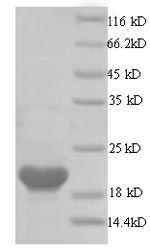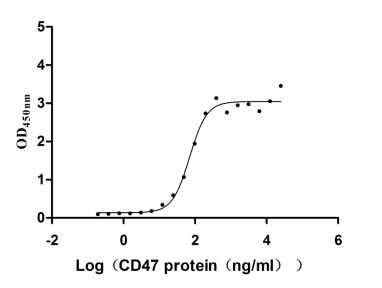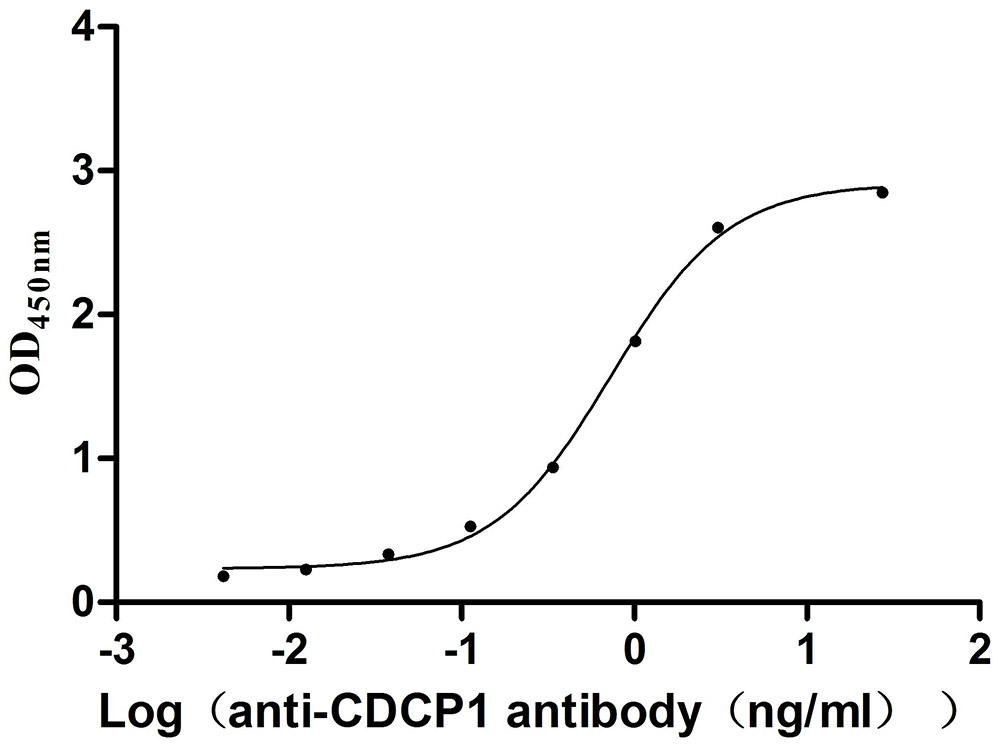Recombinant Human papillomavirus type 16 Protein E6 (E6)
In Stock-
货号:CSB-YP365854HML
-
规格:¥1500
-
图片:
-
其他:
产品详情
-
纯度:Greater than 90% as determined by SDS-PAGE.
-
基因名:
-
Uniprot No.:
-
别名:E6; Protein E6
-
种属:Human papillomavirus type 16
-
蛋白长度:Full Length
-
来源:Yeast
-
分子量:21.2 kDa
-
表达区域:1-158aa
-
氨基酸序列MHQKRTAMFQDPQERPRKLPQLCTELQTTIHDIILECVYCKQQLLRREVYDFAFRDLCIVYRDGNPYAVCDKCLKFYSKISEYRHYCYSLYGTTLEQQYNKPLCDLLIRCINCQKPLCPEEKQRHLDKKQRFHNIRGRWTGRCMSCCRSSRTRRETQL
Note: The complete sequence including tag sequence, target protein sequence and linker sequence could be provided upon request. -
蛋白标签:N-terminal 6xHis-tagged
-
产品提供形式:Liquid or Lyophilized powder
Note: We will preferentially ship the format that we have in stock, however, if you have any special requirement for the format, please remark your requirement when placing the order, we will prepare according to your demand. -
缓冲液:Tris-based buffer,50% glycerol
-
储存条件:Store at -20°C/-80°C upon receipt, aliquoting is necessary for mutiple use. Avoid repeated freeze-thaw cycles.
-
保质期:The shelf life is related to many factors, storage state, buffer ingredients, storage temperature and the stability of the protein itself.
Generally, the shelf life of liquid form is 6 months at -20°C/-80°C. The shelf life of lyophilized form is 12 months at -20°C/-80°C. -
货期:3-7 business days
-
注意事项:Repeated freezing and thawing is not recommended. Store working aliquots at 4°C for up to one week.
-
Datasheet & COA:Please contact us to get it.
相关产品
靶点详情
-
功能:Plays a major role in the induction and maintenance of cellular transformation. Acts mainly as an oncoprotein by stimulating the destruction of many host cell key regulatory proteins. E6 associates with host UBE3A/E6-AP ubiquitin-protein ligase, and inactivates tumor suppressors TP53 and TP73 by targeting them to the 26S proteasome for degradation. In turn, DNA damage and chromosomal instabilities increase and lead to cell proliferation and cancer development. The complex E6/E6AP targets several other substrates to degradation via the proteasome...显示更多
-
基因功能参考文献:
- USP15 could increase the level of HPV16 E6 by inhibiting E6 degradation. PMID: 29895155
- Up-regulation of miR-20a by HPV16 E6 exerted growth-promoting effects by targeting PDCD6 in cervical carcinoma cells. PMID: 29710555
- The HPV16-E6 oncoprotein induces EMT in transgenic mice cataracts. The molecular mechanism may involve TGF-beta and Wnt/beta-catenin pathways, suggesting that the K14E6 transgenic mouse could be a useful model for the study or treatment of EMT-induced cataracts. PMID: 29888254
- This study provides links between the DNA damage response, the regulation of E6 human papillomavirus type 16 PDZ binding motif function, and the inhibition of p53 activity and begins to explain how virus-infected cells remain within the cell cycle, despite activation of DNA damage response pathways during productive virus infections. PMID: 29848585
- E6 oncogene alters host gene expression in the cervical stroma. PMID: 29073104
- the K14E6 versus K14E6Delta146-151 transcriptional profile provides a source of valuable data to uncover novel E6 functions in the skin. PMID: 29130045
- HPV16 E6 T178G mutation increases the disease risk of cervical intraepithelial neoplasia 2 and 3 PMID: 29787003
- the network of transcriptional interactions in HPV16-infected basal-type cervical epithelium is regulated in a concentration-dependent manner by E6/E7, via a limited number of central master-regulators. PMID: 27457222
- E6 association with cellular PDZ proteins promotes the nuclear localization of YAP1. PMID: 29346075
- Results showed that increased expression of HPV16 E6 expression level was strongly associated with malignant transformation of the cervical epithelium and the histological progression of cervical squamous cell carcinoma. PMID: 29470526
- human papillomavirus 16 E6, E7 genes and Long Control Region are expressed in cervical samples from Uruguayan women PMID: 29454092
- HPV16 E6 oncoprotein promoted the bioactivities of non-small cell lung cancer (NSCLC) cells. TLR3-Src signaling pathway might be involved in this procession by up-regulation of cytokine production. The interaction between HPV16 E6 protein and TLR3 might contribute to the poor prognosis of NSCLC. PMID: 28480962
- HPV16 E6-E7 promotes cancer stem-like cells phenotype in esophageal squamous cell carcinoma cells through the activation of PI3K/Akt signaling pathway PMID: 27489353
- Studied role of HPV16 E6 and COX-2 in invasive ductal breast cancer using qPCR and IHC, and in vitro studies. Found HPV16 E6 promoted breast cancer proliferation; Cox-2 inhibition suppressed HPV16 E6 effects on proliferation thru NF-kappaB signaling pathway. PMID: 29250535
- Findings indicate O-linked N-acetylglucosamine transferase (OGT) as a cellular factor involved in human papillomaviruses type 16/18 E6 and E7 expressions and cervical cancer tumorigenesis, suggesting that targeting OGT in cervical cancer may have potential therapeutic benefit. PMID: 27331873
- IFN-beta treatment leads to p53-indipendent apoptosis in K16 cells whereas induces senescence in K16 cells if E6 is silenced and p53 expression is restored. The levels of selected miRNAs, deregulated in K16 and K38 cells, can be modulated by IFN-beta when E6 and E7 proteins of HPV-16, but not HPV-38, are expressed. PMID: 26748726
- A decrease in miR-184 level by E6 oncoprotein may predict unfavorable response to cisplatin-based chemotherapy in HPV-infected non-small cell lung carcinoma patients via increasing Bcl-2 expression. PMID: 27083050
- Seminal studies over the last two decades have identified the transcriptional, epigenetic, and post-transcriptional roles high-risk E6 and E7 have in TERT regulation. (Review) PMID: 27863966
- Ablation of E6 by siRNA induces the tumor suppressor p53 and diminishes beta-defensin-3 (hBD3) in HPV-16 positive CaSki cervical cancer cells and UM-SCC-104 head and neck cancer cells. PMID: 27034006
- This study identifies NFX1-123 as a critical host protein partner through which 16E6 is able to subvert the immune response and in turn permit a long-lived high-risk Human papillomavirus infection. PMID: 29117186
- HPV E6 is capable of overriding this regulation and can promote degradation of p53 and Dlg regardless of the phosphorylation status of E6AP. PMID: 28835500
- Studies indicate the accuracy of HPV16 antibodies to the oncoproteins E6. PMID: 28316084
- Lactate and glucose production were enhanced in E6-transduced keratinocytes, likely due to raised levels of metabolic enzymes, but independent of(HIF-1alpha activity. PMID: 28857035
- These data highlight the importance of the carboxy-terminal motif of the E6 protein and downregulation of PAR3 in tumorigenic transformation of human cervical keratinocytes. PMID: 28440909
- Study presented a combined molecular dynamics/infrared spectroscopy approach to the study of ligand binding (11-residue peptide derived from the C terminus of HPV16 E6) by the PDZ1 domain of MAGI1, focusing in particular on the far-infrared region of the spectrum. PMID: 28636914
- HPV16 E6/E7 oncogene expression in primary human epithelial cells alters miR expression in extracellular vesicles. PMID: 28500882
- In three warty or basaloid SCSC HPV16-DNA and E6*I-mRNA were detected. LCM-PCR confirmed HPV16 was in p16(INK4a)-positive malignant cells. However, of three usual-type SCSC, all were HPV-negative and two expressed p53 protein but not p16(INK4a). PMID: 28376081
- HPV-16 E6 was confirmed to regulate microRNA miR-23b indirectly through the DNA methylation of host gene C9orf3 and thus induce c-MET and inhibit apoptosis in cervical cancer cells. PMID: 28077801
- Our results indicate that HPV16 E6/E7 indirectly upregulated the expression of VEGF by inhibition of liver kinase B1 expression and upregulation of hypoxia-inducible factor 2alpha expression,thus propose a human papillomavirus-liver kinase B1-hypoxia-inducible factor 2A-vascular endothelial growth factor axis for the tumorigenesis of lung cancer PMID: 28720067
- HPV E6/E7 increased expression of DROSHA and DICER mRNA and protein in cervical carcinoma cells. PMID: 28448850
- Data show that p63 transcription factors modulate cell migration via Src-focal adhesion kinase (FAK) signaling in foreskin keratinocytes (HFK) expressing human papilloma virus (HPV)16 E6/E7 genes. PMID: 26001294
- Overall, this study supports the model that perturbation of cellular miR expression by human papillomavirus type 16 E6/E7 importantly contributes to the rewiring of cellular regulatory circuits that contributes to oncogenic transformation. PMID: 28049151
- Thus, Brd4 activates human papillomavirus 16 transcription at this integration site, and strong selection for E6/E7 expression can drive the formation of a super-enhancer-like element to promote oncogenesis. PMID: 27624132
- Collectively, these results indicate that human papillomavirus 16 E6 induces upregulation of APOBEC3B through increased levels of TEADs, highlighting the importance of the TEAD-APOBEC3B axis in carcinogenesis. PMID: 28077648
- A transcriptomic landscape of human papillomavirus 16 E6-regulated gene expression and splicing events in cervical cancer patients has been presented. PMID: 27859058
- The ubiquitylation of beta-catenin by E6AP was dependent on its E3 ubiquitin ligase activity, but it was proteasome-independent and did not require HPV16-E6. PMID: 27902311
- nucleotide changes in E6 occur significantly more often in the mixed form of viral DNA and in low-grade squamous intraepithelial lesions; and the variants without additional mutations may promote integration of HPV16 genome. PMID: 27801430
- We also found VPA suppressed oncogene E6 in a Notch-independent manner, and induced significant apoptosis in E6-overexpressing HPV positive CaSki cells. PMID: 27176495
- Data show that alpha-linolenic acid (ALA) decreased the expression of VEGF and COX2 proteins, and reduced the expression of Human papillomavirus type 16/18 onco-proteins E6 and E7, resulting into restoration of expression of tumor suppressor proteins, p53 and Rb in cervical cancer cell lines. PMID: 26440049
- Expression changes of E6 and E7 significantly promoted the protein expression of HIF-1alpha, the expression of both protein and mRNA of GLUT1, but had no effect on the expression of HIF-1alpha mRNA in lung cancer cells. PMID: 26508030
- our results suggest that ERK1/2 signaling pathway is involved in HPV-16 E6 but not E7 oncoprotein-induced HIF-1a, VEGF, and IL-8 expression in NSCLC cells, leading to the enhanced angiogenesis in vitro. PMID: 26931433
- Our data suggest that the use of HPV 16 spliced transcripts may help to predict for poorer outcomes in patients with HPV positive oropharyngeal cancer PMID: 26575468
- Within the limitations of this study, the immunoexpression of HPV 16/18 E6 and E7 oncoproteins may have prognostic value regarding cervical squamous intraepithelial lesions persistence in HIV-positive women. PMID: 26909984
- HPV16 E6/E7 Oncoproteins Alter the In Vitro Growth of CD44+NGFR+ Human Tonsillar Epithelial Cells. PMID: 26527383
- Human papillomavirus type 16 E6 protein, a major etiological molecule of cervical cancer, maintains high YAP protein levels in cervical cancer cells by preventing proteasome-dependent YAP degradation to drive cervical cancer cell proliferation. PMID: 26417066
- E6 and E7 have roles in methylation of tumor suppressor genes and inducing phenotype transformation of human cervical carcinoma cells PMID: 26329329
- Here we demonstrate that E7, and to a lesser extend E6, strongly reduce NFkappaB activation in response to the inflammatory mediator imiquimod. Moreover, we establish that undifferentiated keratinocytes do not express the putative receptor for imiquimod, TLR7 PMID: 26268216
- The data indicate for the first time that increased cytoplasmic human papillomavirus type 16 E6 levels associated with malignant progression alter Cx43 trafficking and recycling to the membrane and the E6/human Dlg interaction may be involved. PMID: 26445057
- High-risk HPV-type lesions might inhibit the chemokine CCL20 on Langerhans cells through E6 and E7 to escape the immune response. PMID: 26400278
- E6 protein functioning as a host miRna modulator and play a role of HPV induced carcinogenesis in patient diagnosed with cervical cancer. PMID: 26384051
收起更多
-
亚细胞定位:Host cytoplasm. Host nucleus.
-
蛋白家族:Papillomaviridae E6 protein family
-
数据库链接:
KEGG: vg:1489078





















